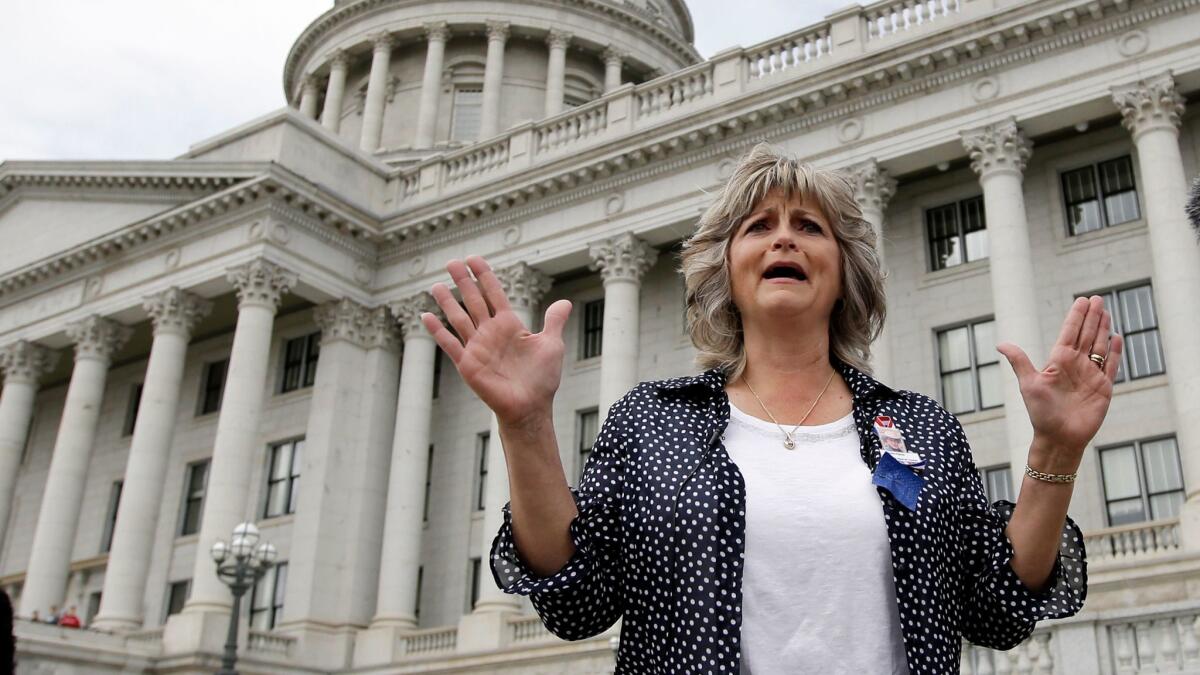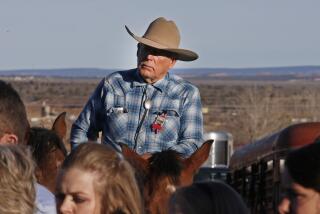After police killed LaVoy Finicum, Jeanette Finicum takes up her husband’s cause and his work

- Share via
Before the police shot and killed her husband, Jeanette Finicum didn’t know anything about ranching.
Since then, she’s learned how to castrate cattle, drive a backhoe and a forklift — the kind of work her husband, Robert “LaVoy” Finicum, used to do, before he joined the ill-fated armed occupation of the Malheur National Wildlife Refuge in Oregon in January 2016.
She now oversees 80 head of cattle on her family’s 16,000-acre allotment of federal grazing land, called “Tuckup,” in remote northern Arizona.
Perhaps 16,000 acres sounds like a lot. (It’s 25 square miles, slightly larger than Manhattan, or triple the size of Santa Monica.) But Finicum, 57, calls herself a “very small rancher” — not some big shot.
“It’s actually quite a lot of fun, and I enjoy being out on horseback up on the mountains,” Finicum said in an interview on Friday, the two-year anniversary of her husband’s death. “It’s peaceful. You can just feel God’s hand in nature up there.”
‘We are not leaving’: The final days of an Oregon occupier »
Finicum sounded at ease on the phone. But she had just filed a wrongful-death lawsuit seeking at least $5 million in damages on behalf of her family against huge swaths of government — specifically, the United States; the FBI; the Bureau of Land Management; Sen. Ron Wyden (D-Ore.); the Oregon State Police; the governor of Oregon; Harney County, Ore.; a variety of other officials; an ecological activist group; and “John Does 1-100.”
Like LaVoy Finicum, Jeanette Finicum has gotten a taste for fighting the system.
“We want justice and accountability for the death of my husband, LaVoy,” Finicum said. “Our government planned a kill stop out on a remote piece of road where there was no cellphone access; they had planned many days in advance; they had called in a special unit team from D.C., a SEAL team; they had snipers in the trees; they clearly, from their actions, had planned to harm and hurt someone that day, if not everyone.”
Actually, it was an elite FBI Hostage Rescue Team, not Navy SEALs, that had been lying in wait.
On Jan. 26, 2016, LaVoy Finicum, 54, a spokesman for the occupiers, was leading a two-car convoy on a remote stretch of highway near Burns, Ore., with some of the leaders of the Malheur occupation.
The occupation started as an armed protest of the nation’s federal wildlands policies. No violence had broken out, but the protesters had occupied the refuge’s facilities with pistols and rifles, alarming many observers and government officials. And on that day, after waiting more than three weeks, officials decided to put an end to the affair.
Police pulled up from behind and pulled over Finicum and the driver of the vehicle behind him. Soon, Finicum, driving the lead vehicle, raced away from the traffic stop. But waiting around a curve in the road ahead was a roadblock with armed Oregon State Police and FBI special agents.
One Oregon State Police trooper fired three shots at Finicum’s truck as the rancher sped toward a law enforcement roadblock at 70 mph and crashed into a snowbank on a rural Oregon highway.
Then, after Finicum got out of the truck, the rancher reached for a loaded gun in his jacket, and two state troopers shot him three times, according to investigators who reviewed the shooting, which was deemed justifiable “and, in fact, necessary,” by Malheur County Dist. Atty. Dan Norris.
The chase and the shooting were also captured by aerial footage that officials soon released, which did little to mollify Finicum’s supporters, who were angered by the trap and the fact that Finicum was shot in the back, without a gun in his hand.
Their skepticism only grew when a federal grand jury indicted a member of the FBI’s Hostage Rescue Team, W. Joseph Astarita, on suspicion of shooting twice at Finicum during the encounter, and missing him, but then lying about it to state and federal investigators. (Astarita pleaded not guilty and recently requested that the case be dismissed before trial, claiming the allegations identifying him as the mystery shooter were based on “junk science” by forensic experts.)
Astarita’s indictment was far from the federal government’s only black eye involving the occupiers.
In October 2016, an Oregon jury acquitted seven occupiers of weapons charges and conspiracy to intimidate federal workers. Three had represented themselves. A year later, a Nevada jury acquitted four supporters of the Bundy family, which was involved in a similar armed standoff near Bunkerville, Nev., in 2014.
Why can’t the federal government win convictions against Cliven Bundy and his family? »
Then, a month ago, a federal judge declared a mistrial in a case against ranch patriarch Cliven Bundy and two of his sons after she found that prosecutors “willfully” failed to turn over evidence involving the Nevada standoff.
So given the government’s track record, when Jeannette Finicum files a lawsuit against seemingly everybody on the other side, it’s hard to say that the case doesn’t have a shot, even though the law often gives ample protections to law enforcement officials accused of wrongful shootings — and even though her complaint starts by comparing the U.S. to North Korea.
“I don’t believe he was ‘repeatedly’ reaching for a gun,” Jeannette Finicum said, responding to the government’s account of why Oregon state police shot Finicum. “My husband didn’t carry his weapons recklessly like that. He was responsible. He always had been; so I don’t believe that theory.”
An FBI spokeswoman declined to comment on the pending litigation.
Finicum was far from alone after her husband’s death. The couple had 12 children, and her advocacy on his behalf — which includes traveling to speaking engagements with ideological supporters — has also attracted an army of well-meaning strangers into her life.
“I had these two young boys come all the way down from Washington state, stayed two weeks and built three miles of fence,” Finicum said. Another “gentleman” helped her fix her truck. “A couple spent their honeymoon with me, just wanted to come out and meet us, went looking for cows. It was just really wonderful.”
She lost a husband, but, Finicum said, “I feel like my family has grown by thousands.”
Matt Pearce is a national reporter for The Times. Follow him on Twitter at @mattdpearce.
More to Read
Sign up for Essential California
The most important California stories and recommendations in your inbox every morning.
You may occasionally receive promotional content from the Los Angeles Times.














